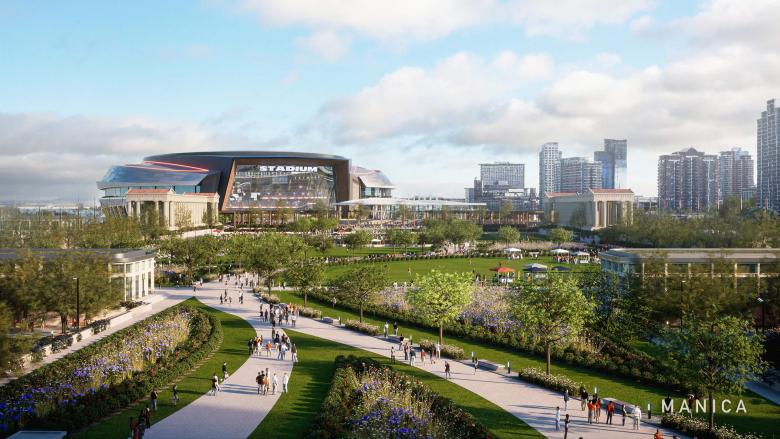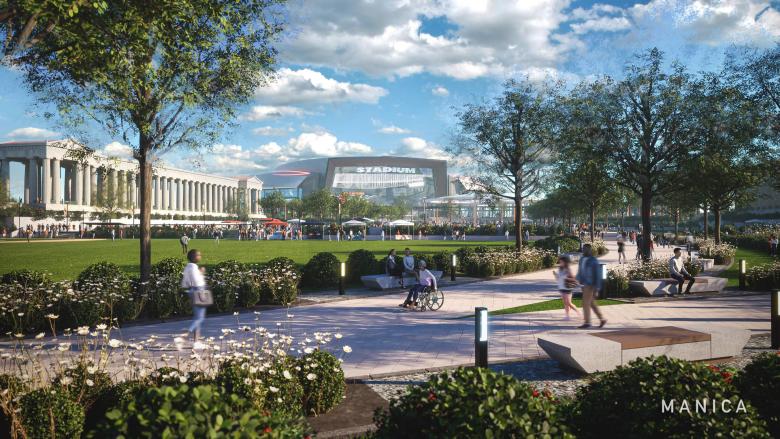‘Forever open, clear, and free’?
Chicago Bears Propose New Lakefront Stadium
Twenty-one years after the Chicago Bears landed a glass-and-steel seating bowl inside the iconic Soldier Field, the NFL team is proposing to tear down the stadium and build a new domed stadium just steps away, saving the original's colonnades as an enclosure for outdoor sports fields and gardens.
Chicago's 1836 decree to keep its Lake Michigan shoreline “forever open, clear, and free of any buildings” has not precluded buildings on the lakefront, but it has meant than any attempt to violate the decree that was made into law in 1973 has been met with virulent opposition. This century, those attempts and their related controversies have been centered southeast of the Loop, on a stretch of lakefront from the Field Museum on the north to McCormick Place's Lakeside Center on the south. It started in 2000 with the Chicago Bears' ultimately successful proposal to build a modern seating bowl, designed by Wood + Zapata, within the neoclassical colonnades of Soldier Field, designed by Holabird & Roche and built in 1924. More recently, a site just south of Soldier Field was targeted by George Lucas for his Museum of Narrative Art, but lawsuits against the project related to protecting the lakefront led him to build it in Los Angeles instead. The controversies continue with the Bears' proposal, released on April 24, to build a new domed stadium just south of Soldier Field.
Why a new stadium, and why now? Although the Bears have played at Soldier Field since 1971, and the 2003 insertion was tailor made for National Football League (NFL) games, the stadium is publicly owned by the Chicago Park District. The Bears lease the stadium at the cost of approximately $6.5 million annually, and their current lease expires in 2033. They can break the lease early, paying a penalty to do so, and that is what they threatened to do in 2021, when they made an agreement to purchase an old racetrack in suburban Arlington Heights that they would tear down and replace with a new stadium (the team made similar threats as far back as the 1970s). The City of Chicago, under Mayor Lori Lightfoot, made a counter proposal in 2022, offering multiple plans for increasing the capacity and amenities at Soldier Field, but that proposal was a nonstarter and the Bears went ahead with the purchase of the land in Arlington Heights. But with the election of Chicago Mayor Brandon Johnson and the Bears hiring Kevin Warren as president, both last year, the two started to work out a compromise to keep the Chicago in the Chicago Bears.
Although the Bears are promising to pay $2 billion (or 70% of the total cost) toward the construction of the new stadium, and the plan shows additional park land in the form of sports fields and other recreational uses, the attempt to build a new stadium just south of Soldier Field faces two major obstacles:
- Convincing taxpayers to subsidize the stadium to the tune of many millions of dollars,
- Likely legal challenges related to the city’s 1973 Lakefront Protection Ordinance.
Complicating the first matter are the fact taxpayers are still paying off nearly $590 million in debt from the 2003 stadium that cost $609 million, about 50% over its original estimates, and Mayor Johnson's assertion that he would not give public money to the Bears and the White Sox, one of the city's professional baseball teams, for new stadiums. Still, many Chicago residents are still displeased with the stylistic opposition of the existing stadium relative to the colonnades (it led to the removal of landmark designation at Soldier Field in 2006), so returning the 1924 remnants to their near-original appearance may appease them.
The Bears are clearly anticipating the second matter, as their proposal indicates the new stadium would be publicly owned and, given that it would have a fixed roof, would be used year-found for many events outside of NFL games, including other sports and concerts. The Bears contend that enclosing the stadium also means it could be a venue for Super Bowls, NCAA Final Fours, and other tournaments. as well as And while the renderings also depict public green spaces between and around the colonnades, there's no indication that the Bears would help finance them.
Although the Bears' April 24 press release does not mention them by name, the design of the proposed stadium is being led by MANICA, the Kansas City firm founded in 2007 by David Manica, previously at HOK Sport. Speaking with VenuesNow, Manica described the stadium's architecture as “both modern, but has traditional elements in it; using colors and materials similar to the Field Museum.” Those materials and elements include ceramic, metal panels, and wood, though the glass features are the most attention-getting: the translucent roof, similar to MANICA's designs for the Raiders’s Allegiant Stadium in Las Vegas and the Titan’s Nissan Stadium in Nashville; and the glass wall facing the adjacent colonnades and the Loop in the distance.
Ultimately, the design and the decision to build a new stadium — although it's framed in terms of job creation, increased park space, and hosting a Super Bowl — is about seating. Soldier Field accommodates 61,500, the lowest of the 30 venues in the NFL, while reports indicates the new stadium would have somewhere around 65,000 to 70,000 seats. While these numbers would still keep them outside of NFL top ten, “the new stadium will have much better sightlines, more leg room and greater seat width than Soldier’s Field’s seating bowl shoehorned between the historical columns,” per VenuesNow. Comfort and viewing conditions would trump numbers of seats and tickets.
If all goes according to plan for the Bears, the stadium and necessary infrastructure improvements would start construction in 2025 and be completed by 2028.







